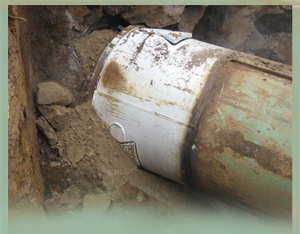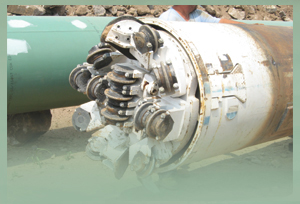The Benefits of Disc Cutters
 Hard rock is the true nemesis to the auger boring contractor and the evolution of auger boring know-how and its increased recognition, as well as being a more widely used and understood method of underground technology has introduced disc cutter head product tooling. The disc cutter concept borrows a smaller diameter platform the cutting method that large tunneling machines utilize to rotate, fracture and remove rock chip spoils from the bore path.
Hard rock is the true nemesis to the auger boring contractor and the evolution of auger boring know-how and its increased recognition, as well as being a more widely used and understood method of underground technology has introduced disc cutter head product tooling. The disc cutter concept borrows a smaller diameter platform the cutting method that large tunneling machines utilize to rotate, fracture and remove rock chip spoils from the bore path.
Manufacturers like American Augers are developing and seeing field-proven results in their version of the disc cutter head. One example of creating success with man, machine and technology is an August 2007 auger boring job in Doylestown, Pa., through an unyielding rock formation.
The contract in Doylestown called for the Case Boring Corp. from Gasport, N.Y., which was subcontracted through Henkels & McCoy, to install a 120-ft long gas pipeline under a two-lane roadway. Confronting the span of the bore was a sandstone deposit that the disc cutter was more than capable of surmounting, as the engineering design is suitable for intrusive rock formations up to 25,000 psi.
“The [American Augers] disc cutter head was the exact right choice for the job. It was effective and productive in both solid and very fissured rock; the type of rock that can give a boring contractor fits with other types of tooling,” said Mark Case from Case Boring Corp.
The Case Boring crew created a 50-ft long and 9-ft deep shored pit, operating on 30 ft of auger boring extension tracking that would set the stage for either achieving success or create a project deficiency in less than ideal conditions.
From the perspective of the contractor, the advantage to using a disc cutter head is that the unit is mounted directly to the product casing, which enhances cutter head stability and allows for a longer cutter life. The individual cutters are manufactured with high-strength steel that allow for increased working life because during use, they perform a rolling motion that creates no friction, and benefits the operator by maximizing performance in various geological formations and are designed to withstand the sever loading of mixed face conditions.
Disc cutter heads have the ability to be industry-wide contributors because they are compatible to any make or model of auger boring machine and auger section that is fitted with a 4- or 5-in. hex.
Using a 1990 model of a 60-1200 auger boring machine and a brand new 36-in. diameter disc cutter head, both manufactured by American Augers, the Case Boring operator began the effort of pushing the product through the sedimentary landscape at a steady rotational speed. Maintaining consistent speed in a slow, but optimum range of 17 to 25 rpm allows disc cutter heads to work through the bore at a pace that ensures a steady flow of the rock cuttings and prevents any significant hindrance to the spoil return process. For this job, the spoils varied from a powdery dirt substance to fingernail clipping size remnants.
The rpm rate must be balanced to coincide to the thrust pressure being produced by the auger boring machine. Throughout the total distance bored, the auger boring crew had to keep a careful eye on the variable factors that influence the amount of thrust to apply including psi level of the rock being cut, total size of the bore, rate of spoil return, diameter of the cutting head and overall machine torque output and speed. This bore maintained a variable output of 220,000 ft-lbs of thrust.
An excavator was also introduced, as the excavator bucket was placed on the product casing in proximity of the disc cutter to apply pressure and aid in the stability of the cutter, as it made the initial penetration of the rock wall. This practice is typical for most disc cutter head jobs because the critical nature of the cutter’s first contact with earthen embankment will create some vibration that if not supported or monitored could cause the line of the bore to be compromised. The excavator was withdrawn shortly after the entire disc cutter had disappeared into the formation, and the vibration ceased because the head and the product casing was now shrouded in the compact composition of the earth, and the operators of the bore had settled the machine into a “sweet spot” that would allow them to steadily progress.
The bore was done at 0 percent grade, but if maintaining line and grade was required, the disc cutter is equipped with power assisted steering jacks, which promotes steering corrections that can be made with ease.
In total it took one and a half days to complete the bore and without the disc cutter, would have made a traditional auger bore difficult and time consuming.
“Using conventional product tooling, this bore would have been possible, but we may have only been able to bore 5 to 8 ft per day,” said Jim Lee, American Augers field service technician who was present during the bore. “I know from experience using a traditional rock cutting head in that type of sandstone would of required constant maintenance in replacing the carbide bullet tips every 2 or 3 ft.”
Case concurred with Lee. “Without the disc cutter the bores would have taken three times longer to complete, involving considerable retooling and time spent pulling and reinserting the auger. The head turned very easily, greatly reducing wear and tear on our auger string and drive train,” Case said.
 Auger boring and its associated equipment or tooling like disc cutter heads are typically less expensive and reduce downtime more so than other methods such as microtunneling and the conventional practice of open trenching. In neighborhoods, metropolitan zones, wetlands/waterways and in infrastructure development (i.e. roads, railways and existing utility) areas auger boring creates less physical disruption and can save a considerable amount of expense on product installation, reduce restoration costs and it provides a tremendous amount of goodwill to the community and its inhabitants.
Auger boring and its associated equipment or tooling like disc cutter heads are typically less expensive and reduce downtime more so than other methods such as microtunneling and the conventional practice of open trenching. In neighborhoods, metropolitan zones, wetlands/waterways and in infrastructure development (i.e. roads, railways and existing utility) areas auger boring creates less physical disruption and can save a considerable amount of expense on product installation, reduce restoration costs and it provides a tremendous amount of goodwill to the community and its inhabitants.
Another downtime limiting factor for disc cutter heads is that the large diameter of the head allows for the head to retract from the face without moving the product casing. Having the cutting head be retractable also allows for cutter change and service that can be accomplished outside of the heading.
Auger boring itself is a test of both man and machine, but when those two factors are confronted with tough ground formations that can stress human emotions and mechanical muscle, the real test is how utilizing proven practices and today’s technology like disc cutter heads are used to prevail in complicated situations.
“The disc cutter head will allow us to make bores in a much more cost-effective way than ever before. We will be able to entertain longer crossings than ever before due to the easy turning nature of the head and the unique steering advantages the head give us,” said Case.
Rob Foster is marketing manager at American Augers, based in West Salem, Ohio.
![]()
